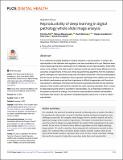Files in this item
Reproducibility of deep learning in digital pathology whole slide image analysis
Item metadata
| dc.contributor.author | Fell, Christina | |
| dc.contributor.author | Mohammadi, Mahnaz | |
| dc.contributor.author | Morrison, David | |
| dc.contributor.author | Arandjelovic, Ognjen | |
| dc.contributor.author | Caie, Peter | |
| dc.contributor.author | Harris-Birtill, David | |
| dc.date.accessioned | 2022-12-05T10:30:09Z | |
| dc.date.available | 2022-12-05T10:30:09Z | |
| dc.date.issued | 2022-12-02 | |
| dc.identifier | 282443908 | |
| dc.identifier | d5e0e037-75d1-431c-9410-ab66ef085114 | |
| dc.identifier.citation | Fell , C , Mohammadi , M , Morrison , D , Arandjelovic , O , Caie , P & Harris-Birtill , D 2022 , ' Reproducibility of deep learning in digital pathology whole slide image analysis ' , PLOS Digital Health , vol. 1 , no. 12 , e0000145 . https://doi.org/10.1371/journal.pdig.0000145 | en |
| dc.identifier.issn | 2767-3170 | |
| dc.identifier.other | RIS: urn:B39115068696B0F5F768476BEF864970 | |
| dc.identifier.other | ORCID: /0000-0002-0740-3668/work/124490185 | |
| dc.identifier.other | ORCID: /0000-0001-5502-9773/work/136696661 | |
| dc.identifier.uri | https://hdl.handle.net/10023/26542 | |
| dc.description | Funding: This work is supported by the Industrial Centre for AI Research in digital Diagnostics (iCAIRD) which is funded by Innovate UK on behalf of UK Research and Innovation (UKRI) [project number: 104690], and in part by Chief Scientist Office, Scotland. | en |
| dc.description.abstract | For a method to be widely adopted in medical research or clinical practice, it needs to be reproducible so that clinicians and regulators can have confidence in its use. Machine learning and deep learning have a particular set of challenges around reproducibility. Small differences in the settings or the data used for training a model can lead to large differences in the outcomes of experiments. In this work, three top-performing algorithms from the Camelyon grand challenges are reproduced using only information presented in the associated papers and the results are then compared to those reported. Seemingly minor details were found to be critical to performance and yet their importance is difficult to appreciate until the actual reproduction is attempted. We observed that authors generally describe the key technical aspects of their models well but fail to maintain the same reporting standards when it comes to data preprocessing which is essential to reproducibility. As an important contribution of the present study and its findings, we introduce a reproducibility checklist that tabulates information that needs to be reported in histopathology ML-based work in order to make it reproducible. | |
| dc.format.extent | 21 | |
| dc.format.extent | 694372 | |
| dc.language.iso | eng | |
| dc.relation.ispartof | PLOS Digital Health | en |
| dc.subject | QA75 Electronic computers. Computer science | en |
| dc.subject | RB Pathology | en |
| dc.subject | DAS | en |
| dc.subject | MCC | en |
| dc.subject.lcc | QA75 | en |
| dc.subject.lcc | RB | en |
| dc.title | Reproducibility of deep learning in digital pathology whole slide image analysis | en |
| dc.type | Journal article | en |
| dc.contributor.sponsor | Technology Strategy Board | en |
| dc.contributor.institution | University of St Andrews. School of Medicine | en |
| dc.contributor.institution | University of St Andrews. School of Computer Science | en |
| dc.contributor.institution | University of St Andrews. Centre for Research into Ecological & Environmental Modelling | en |
| dc.identifier.doi | https://doi.org/10.1371/journal.pdig.0000145 | |
| dc.description.status | Peer reviewed | en |
| dc.identifier.grantnumber | TS/S013121/1 | en |
This item appears in the following Collection(s)
Items in the St Andrews Research Repository are protected by copyright, with all rights reserved, unless otherwise indicated.

